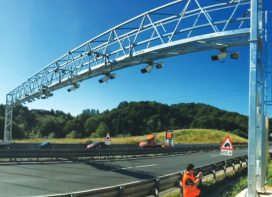Speed cameras that don’t flash? This is the way the truck toll works

Almost four meters high, painted blue-green and equipped with four sensor windows: Colorful enforcement towers can be seen along the roadsides of German highways. New measuring instruments for speed enforcement? No, because they don’t measure the speed, but check the weight classes of the vehicles. The blue towers have been used for truck toll enforcement in Germany since July 1, 2018. The colorful design is intended to differentiate them from conventional speed cameras for the road users. Nevertheless, drivers often confuse the new toll enforcement devices with speed monitoring systems. But if drivers do adhere to the prescribed speed, it’s then unnecessary to brake suddenly and unexpectedly.
Systems from the Toll Collect toll operator are used for truck toll enforcement on German highways. The Federal Ministry of Transport and Digital Infrastructure commissioned Toll Collect with the technical design of the toll systems for collecting and enforcing toll fees. Jenoptik was one of the partners involved in the technical development of the so-called toll enforcement tower.
Only vehicles and vehicle combinations with a permissible total weight of 7.5 tonnes or more are subject to road tolls on German highways. Inside the vehicles, the on-board-unit (OBU) checks whether the vehicle has already paid its toll. The built-in OBU displays the number of axles and the weight of the vehicle while driving.
Advanced technology is used to collect the truck toll. As vehicles drive past, the system checks whether they are subject to toll and, if yes, whether the toll has been correctly paid. How does the technology in the truck toll enforcement towers work?
 Jenoptik offers a unique digital solution for truck toll enforcement systems, which combines various sensor technologies. Sensor systems for distance measurement are coupled with stereo image processing and side cameras, which record and classify passing trucks. This makes it possible for the first time to detect axles using a side camera. The side camera in the toll enforcement tower records within a second individual sections of the passing vehicle at an extremely high frequency. True-to-scale and distortion-free profile pictures are generated from this. This enables an immediate exact measurement of the truck in length, width and size as well as an indisputable identification of the number of axles, which are required for exact classification in the toll table. The toll is then calculated based on the weight. The more axles a truck has, the higher the weight of the loaded vehicle can be.
Jenoptik offers a unique digital solution for truck toll enforcement systems, which combines various sensor technologies. Sensor systems for distance measurement are coupled with stereo image processing and side cameras, which record and classify passing trucks. This makes it possible for the first time to detect axles using a side camera. The side camera in the toll enforcement tower records within a second individual sections of the passing vehicle at an extremely high frequency. True-to-scale and distortion-free profile pictures are generated from this. This enables an immediate exact measurement of the truck in length, width and size as well as an indisputable identification of the number of axles, which are required for exact classification in the toll table. The toll is then calculated based on the weight. The more axles a truck has, the higher the weight of the loaded vehicle can be.
This enables the system to immediately register whether a truck is obliged to pay toll fees. The system documents toll violations with high-resolution images and transmits them to the Toll Collect toll operator so they can impose any subsequent penalties. Engineers, software developers and data protection experts worked closely together on this project in order to guarantee data security and data protection.
Overall, the design of the enforcement systems has had only a minor impact on the environment. Thanks to prefabricated components, they can be installed and assembled easily and non-invasively on the side of the roads in a short time. One advantage of this is that it is only necessary to close the road for a short period of time to install them. Compared to the construction of bridges, the impact on the environment is minimal with their colourful design blending better into the rural landscape of highways.
Will there soon be a car toll in Germany in addition to the truck toll?
The Jenoptik sensor technology is also suitable for road traffic application scenarios of the future. In addition to the truck toll, the introduction of a car toll has been a topic of discussion in Germany for several years. Other countries worldwide have been using road user charging system for years.
 The city of Singapore is a pioneer and introduced car tolls in 1975. The fee is automatically billed via a radio sensor. The City of London is another model. Since 2003, an inner-city congestion charge has been imposed to reduce noise and air pollution. Also in Stockholm, cameras have been recording the number/license plates of vehicles to enforce tolls for several years. New York is the first city in the USA to plan on introducing a car toll in the coming years. However, the starting date of the city toll remains unclear.
The city of Singapore is a pioneer and introduced car tolls in 1975. The fee is automatically billed via a radio sensor. The City of London is another model. Since 2003, an inner-city congestion charge has been imposed to reduce noise and air pollution. Also in Stockholm, cameras have been recording the number/license plates of vehicles to enforce tolls for several years. New York is the first city in the USA to plan on introducing a car toll in the coming years. However, the starting date of the city toll remains unclear.
The Jenoptik sensor technology is also suitable for road traffic application scenarios of the future. In addition to the truck toll, the introduction of a car toll has been a topic of discussion in Germany for several years. Other countries worldwide have been using road user charging system for years. The city of Singapore is a pioneer and introduced car tolls in 1975. The fee is automatically billed via a radio sensor. The City of London is another model. Since 2003, an inner-city congestion charge has been imposed to reduce noise and air pollution. Also in Stockholm, cameras have been recording the number/license plates of vehicles to enforce tolls for several years. New York is the first city in the USA to plan on introducing a car toll in the coming years. However, the starting date of the city toll remains unclear.
The toll enforcement technology by Jenoptik is one example of the successful interplay of market expertise, software development and hardware integration. Allow us to advise you on your solution for more road traffic safety.
Cornelia Ehrler is with Jenoptik’s Corporate
Communications and Marketing
 TrafficInfraTech Magazine Linking People Places & Progress
TrafficInfraTech Magazine Linking People Places & Progress


